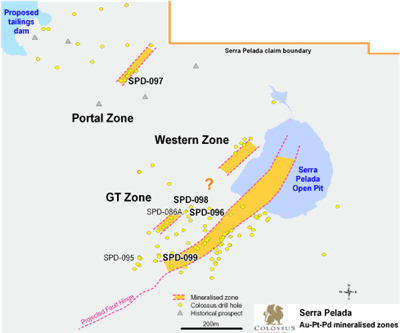
Colossus Minerals Inc. (the “Company” or “Colossus”)(TSX:CSI) is pleased to announce additional assay results from the 25,000 metre surface drilling program at the Serra Pelada Gold-Platinum-Palladium Project, the Colossus-COOMIGASP Joint Venture located in Para State, Brazil.
HIGHLIGHTS
“Drilling such high-grade gold, platinum and palladium approximately 700 metres down plunge from the outcrop of the Central Mineralized Zone in the historic Serra Pelada pit continues to demonstrate the robustness of this mineralized system,” commented Ari Sussman, Colossus CEO. “We wait with great anticipation for early 2012 when construction of the underground decline advances to the point that enables the Company to see the Central Mineralized Zone first hand and extract the first of three 2,500 tonne bulk samples from it.”
DETAILS
Gold-platinum-palladium mineralization at Serra Pelada overprints metasediments occupying the hinge and limbs of a northwest-facing, southwest-plunging, reclined synclinorium that plunges gently southwest from the historical open pit. The CMZ comprises mainly steeply dipping bodies in the fold hinge zone but extends onto the upper and lower limbs of the fold. Characterized by intense hydrothermal carbonaceous and argillic alteration, mainly of siltstones, the CMZ is inboard of siliceous alteration partially mantling the synclinorial hinge. Shallowly dipping gold-platinum-palladium mineralization, for example the Western and GT zones, occurs within siliceous, argillic and carbonaceous alteration and iron oxide-rich breccias on the fold limbs.
Read the full news release here. Image is from Colossus Minerals.